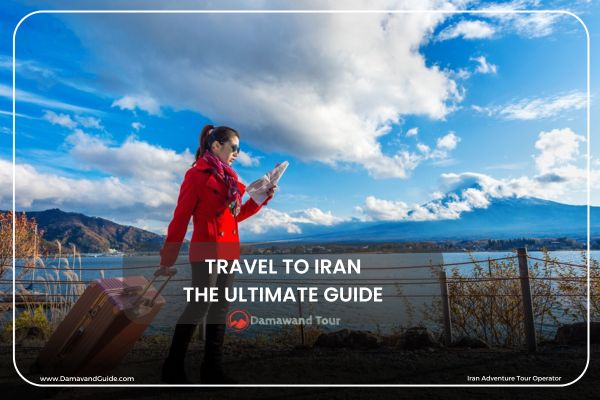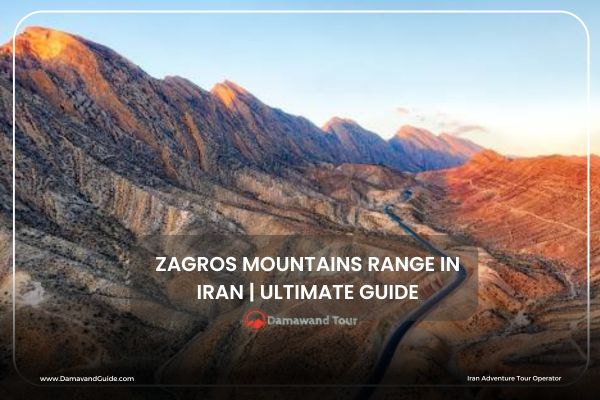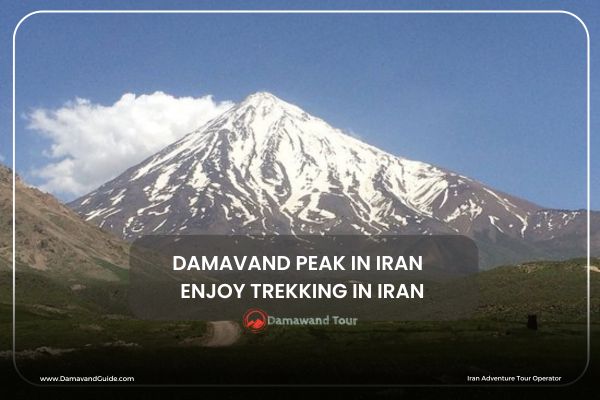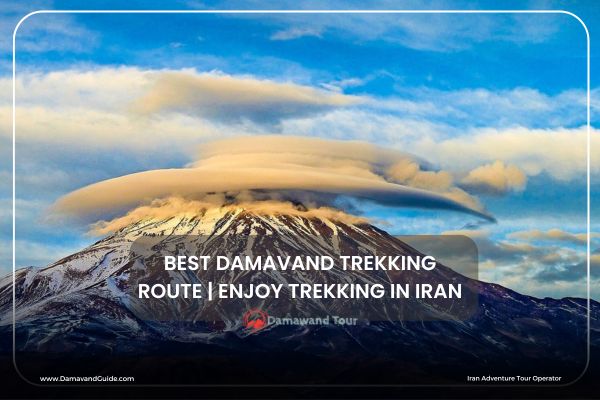
Top Iran Ski Resorts: A Guide to Skiing in Iran ( On-Piste / Off-Piste)
February 7, 2023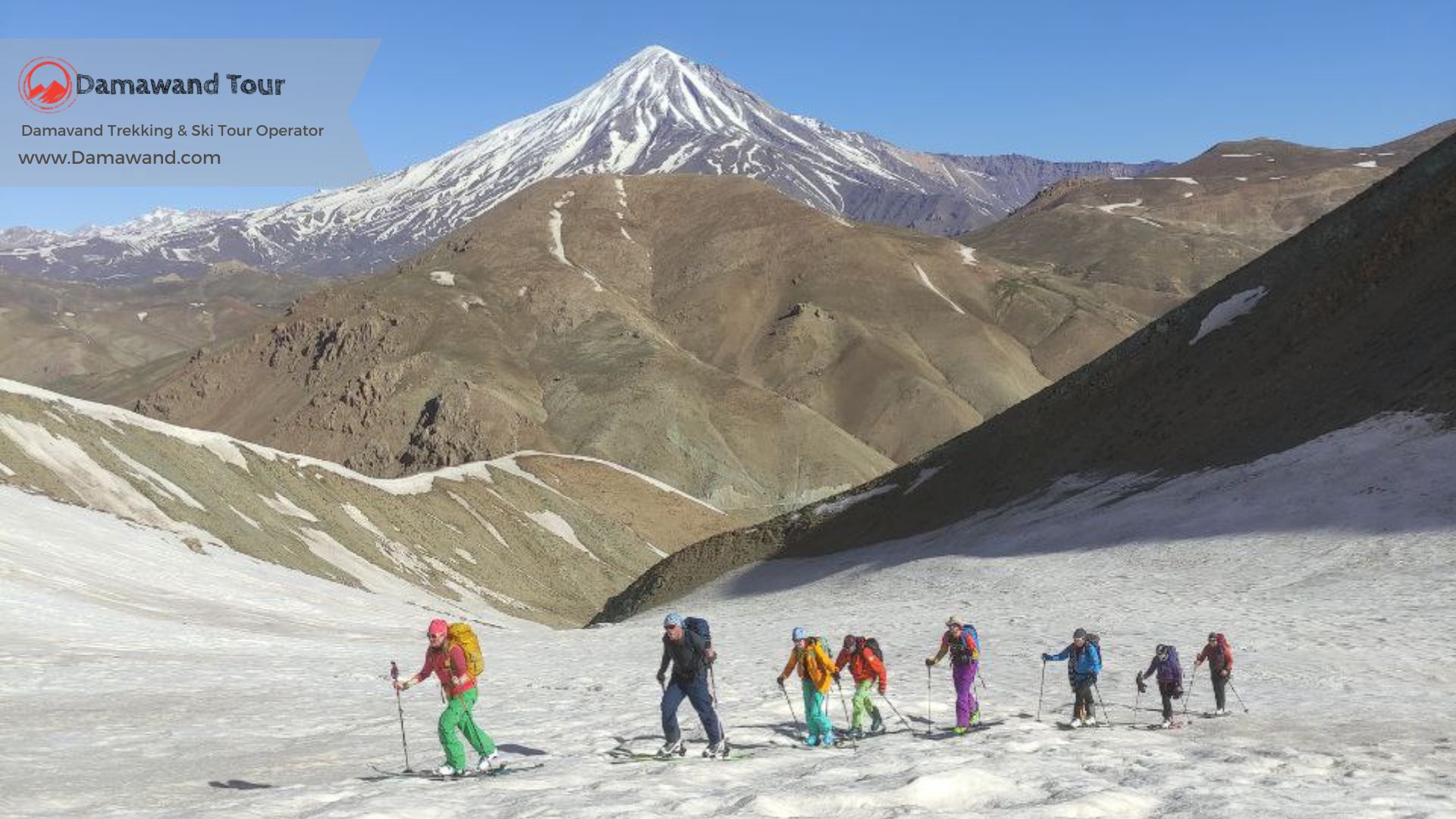
Top Iran Mountains: Ascent Beautiful Heights
March 1, 2023Travel to Iran: The Ultimate Guide (2025)
If you’re looking for a destination that offers a blend of ancient history, vibrant culture, and breathtaking landscapes, then it’s time to travel to Iran. As one of the world’s oldest civilizations, Iran boasts countless treasures, from the stunning ruins of Persepolis to the bustling bazaars of Isfahan and the serene beauty of the Lut Desert. The country’s rich cultural heritage, warm hospitality, and growing tourism infrastructure have made it a rising star among travelers seeking unique experiences.
Planning your trip to Iran, however, requires careful preparation. From understanding Iran travel requirements to learning about local customs and safety tips, having the right knowledge can make your journey more enjoyable and stress-free. Whether you’re exploring iconic landmarks, tasting authentic Persian cuisine, or connecting with locals, this Iran travel guide will help you plan the trip of a lifetime while ensuring you respect the country’s traditions and practices.
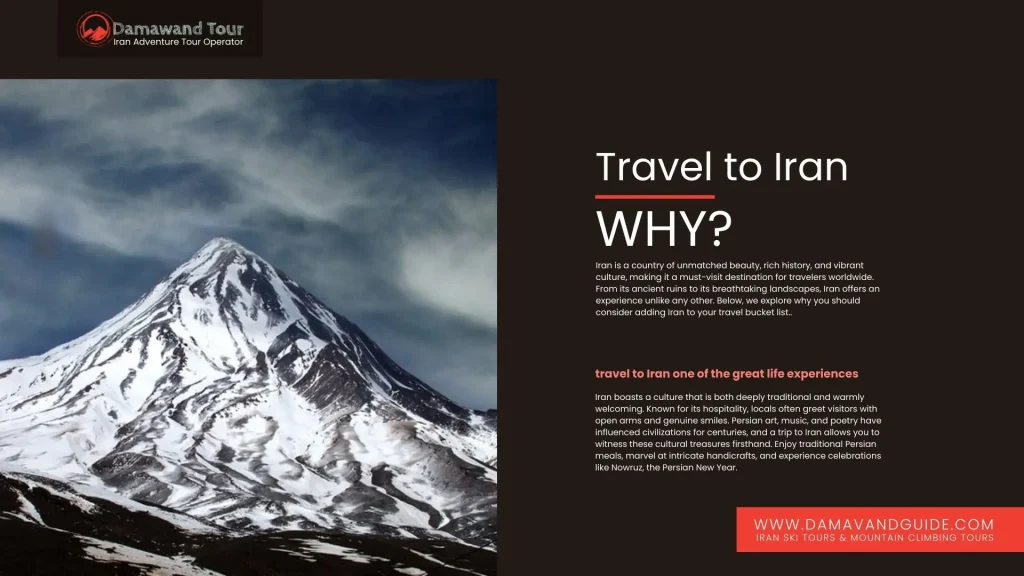
Why Travel to Iran?
Iran is a country of unmatched beauty, rich history, and vibrant culture, making it a must-visit destination for travelers worldwide. From its ancient ruins to its breathtaking landscapes, Iran offers an experience unlike any other. Below, we explore why you should consider adding Iran to your travel bucket list.
A Glimpse into Iranian Culture
Iran boasts a culture that is both deeply traditional and warmly welcoming. Known for its hospitality, locals often greet visitors with open arms and genuine smiles. Persian art, music, and poetry have influenced civilizations for centuries, and a trip to Iran allows you to witness these cultural treasures firsthand. Enjoy traditional Persian meals, marvel at intricate handicrafts, and experience celebrations like Nowruz, the Persian New Year.
Historical Marvels That Tell Stories
Iran’s history stretches back thousands of years, reflected in its well-preserved historical sites. One of the most famous landmarks is Persepolis, the ceremonial capital of the Achaemenid Empire, a UNESCO World Heritage Site. The city of Isfahan is renowned for its stunning Islamic architecture, with the Naqsh-e Jahan Square and Sheikh Lotfollah Mosque standing as masterpieces. Meanwhile, the bustling capital of Tehran offers a mix of modernity and tradition, featuring the Golestan Palace and the National Museum.
Nature’s Wonders
Iran’s natural diversity is another compelling reason to visit. The country has something for every nature lover, from the serene beaches along the Caspian Sea to the vast Dasht-e Kavir desert. The Alborz and Zagros mountain ranges are perfect for hiking and skiing, while lush forests in northern Iran offer tranquil retreats. For adventure enthusiasts, exploring the surreal landscapes of the Lut Desert, another UNESCO site, is an unforgettable experience.
Evolving Safety and Accessibility
In recent years, Iran has become increasingly accessible to tourists. Although it’s always wise to consult an Iran travel advisory for up-to-date information, the country is widely regarded as safe for travelers. Efforts to promote tourism have led to improved infrastructure and clearer communication for visitors. Many who visit are surprised by how secure and comfortable their trip feels, defying outdated perceptions.
Key Tips:
- Check Iran travel information to understand visa requirements and cultural norms.
- Explore cities like Shiraz, home to the famous Pink Mosque and the Tomb of Hafez.
- Respect local customs, including dress codes, to ensure a pleasant experience.
Iran’s mix of history, culture, and nature promises a journey filled with discovery and awe. Whether you’re exploring ancient ruins, strolling through vibrant bazaars, or enjoying the serenity of its landscapes, Iran offers memories to last a lifetime.

Key Iran Travel Requirements
Planning a trip to Iran? Understanding the essential travel requirements will help ensure a smooth and enjoyable journey. From visa applications to health precautions, here’s everything you need to know before visiting this incredible destination.
Visa Process for Iran
Obtaining a visa is one of the most important steps when planning your trip. For most nationalities, a visa is required to enter Iran. Here’s a breakdown of the process:
- Visa on Arrival (VOA): Iran offers visas on arrival to citizens of many countries. You can apply at major airports, such as Tehran Imam Khomeini Airport. However, it’s best to check your eligibility in advance.
- e-Visa: Travelers can apply online through the official Iran Travel Guide website for an e-visa. This is a convenient option and reduces processing time.
- Documents Needed:
- A valid passport (with at least six months of validity)
- A recent passport-sized photo
- A completed visa application form
- A confirmed hotel booking or travel itinerary
- Proof of travel insurance (required for all visitors)
Key Tips:
- Citizens of the United States, Canada, and the United Kingdom need to arrange their visas in advance and must travel with an approved tour guide.
Travel Insurance
Travel insurance is mandatory for all tourists entering Iran. It must specifically cover Iran, as many international policies exclude the country. You can purchase travel insurance at the airport upon arrival, but it’s better to arrange this in advance to avoid delays. Ensure your insurance covers health emergencies, accidents, and cancellations.
Entry Policies and COVID-19 Updates
Travel policies can change quickly, so it’s essential to check the latest Iran travel requirements before your trip. Here are some current policies:
- COVID-19 Regulations: As of now, travelers are required to present a negative PCR test taken within 72 hours before arrival. Proof of vaccination may also be requested at immigration checkpoints.
- Quarantine Rules: There are currently no mandatory quarantine rules for fully vaccinated travelers. However, those showing symptoms might undergo additional screening.
- Health Declaration Form: Fill out the health declaration form upon arrival to ensure compliance with health and safety measures.
Health Precautions and Vaccinations
While no specific vaccinations are required for entering Iran, the following are recommended for a safe trip:
- Hepatitis A
- Typhoid
- Tetanus
- Routine vaccines (e.g., measles, mumps, and rubella)
Travelers should also take basic precautions, such as drinking bottled water and avoiding uncooked street food, to prevent stomach illnesses.
Additional Documents to Carry
To ensure a hassle-free entry, keep these essential documents handy:
- A printed copy of your e-visa or VOA approval letter
- Travel itinerary and hotel reservations
- Emergency contact numbers
- A copy of your passport and other IDs
- Currency exchange receipts (if applicable)
Dress Code and Customs
Iran has a specific dress code that all travelers must follow. Women are required to wear a headscarf and modest clothing that covers their arms and legs. Men should avoid wearing shorts in public. Understanding and respecting local customs will enhance your experience and show respect for Iran’s culture.
By preparing these Iran travel requirements in advance, you can focus on enjoying your trip. Whether you’re exploring historical landmarks or experiencing the country’s natural beauty, staying informed ensures a seamless adventure into the heart of Iran tourism.
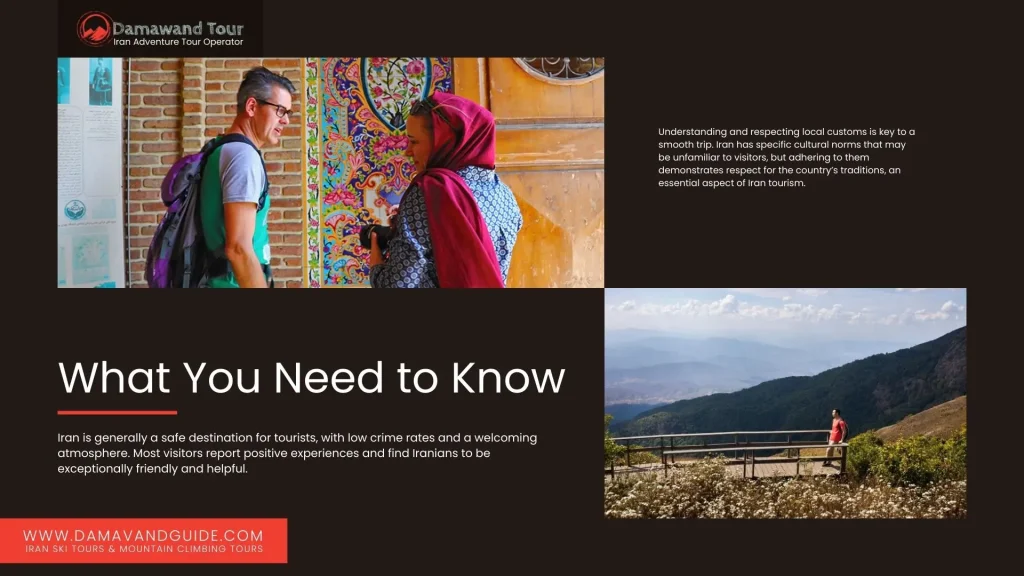
Safety Tips in Travel to Iran: What You Need to Know
Traveling to Iran is an exciting adventure, offering rich cultural experiences, stunning historical sites, and warm hospitality. However, like any travel destination, it’s important to be informed about safety and cultural norms. Here are essential Iran travel advisory tips to ensure a safe and enjoyable trip.
General Safety Overview
Iran is generally a safe destination for tourists, with low crime rates and a welcoming atmosphere. Most visitors report positive experiences and find Iranians to be exceptionally friendly and helpful. However, it’s essential to follow local guidelines and remain cautious, just as you would in any foreign country.
- Tourist Areas: Popular tourist destinations such as Tehran, Isfahan, Shiraz, and Yazd are safe for travelers. These cities have well-developed infrastructures to cater to tourists, making them highlights of any Iran travel guide.
- Avoiding Sensitive Areas: Certain border regions, particularly near Afghanistan, Pakistan, and Iraq, are best avoided due to occasional unrest. Always check the latest Iran travel advisory for updates before your trip to stay informed.
Cultural Norms and Traditions
Understanding and respecting local customs is key to a smooth trip. Iran has specific cultural norms that may be unfamiliar to visitors, but adhering to them demonstrates respect for the country’s traditions, an essential aspect of Iran tourism.
- Dress Code: Iran has a dress code that all visitors must follow. Women should wear a headscarf and modest clothing that covers their arms and legs, while men should avoid shorts in public.
- Behavior in Public: Public displays of affection are frowned upon, and interactions between men and women should remain respectful and formal in public spaces. This is a vital point in any Iran Travel Guide to ensure you adapt well to the local customs.
- Alcohol Prohibition: Alcohol is banned in Iran. Avoid bringing or consuming alcohol to respect local laws and regulations.
Safety Tips for Tourists
- Stay Connected: Carry a local SIM card or ensure you have access to Wi-Fi to stay in touch with family and check for updates related to the latest Iran travel advisory.
- Avoid Political Discussions: It’s best to steer clear of political topics or discussions about government policies while in Iran. This tip is often highlighted in Iran tourism blogs for first-time travelers.
- Use Licensed Guides: When exploring cultural or historical sites, opt for licensed tour guides. They not only provide insightful information but also ensure you navigate safely, which is crucial for a secure and enriching travel experience.
- Transportation: Stick to registered taxis or ride-hailing apps like Snapp for safe and reliable transportation. This advice is frequently recommended in Iran travel guides to help visitors avoid potential scams.
Dealing with Cultural Differences
Iran’s culture is deeply rooted in hospitality, and most Iranians are eager to help tourists. However, here are some tips for navigating cultural differences effectively:
- Language: While Persian (Farsi) is the official language, many Iranians, especially in urban areas, speak basic English. Learning a few Farsi phrases can enhance your Iran tourism experience.
- Taarof (Polite Gestures): Iranians often engage in “taarof,” a cultural form of politeness where they might initially refuse payment or a gift. Be prepared for this custom and understand that it’s polite to offer again.
Insights from Travelers in Travel to Iran
Many travelers who visit Iran highlight the safety and kindness they experience. Stories of strangers helping tourists navigate cities, offering tea, or inviting them into their homes for meals are common. These interactions create lasting memories and reflect the country’s strong tradition of hospitality. Travelers often emphasize how following an Iran travel advisory and respecting local customs ensured their trips were smooth and enjoyable.
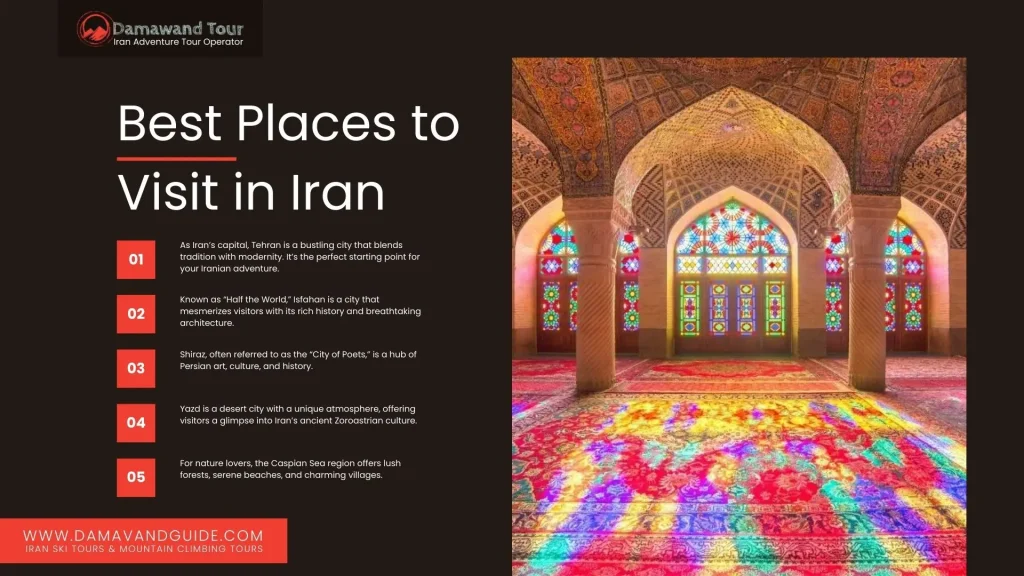
Best Places to Visit in Iran
If you’re planning to travel to Iran, you’re in for a journey filled with history, culture, and natural beauty. Iran offers an incredible variety of destinations, each with its unique charm. Here are some of the best places to visit in Iran, showcasing its top cities, attractions, and experiences.
Tehran: Culture and Shopping
As Iran’s capital, Tehran is a bustling city that blends tradition with modernity. It’s the perfect starting point for your Iranian adventure.
- Top Attractions:
- Golestan Palace: A UNESCO World Heritage Site, this palace showcases stunning Persian architecture and intricate tile work.
- Milad Tower: One of the tallest towers in the world, it offers panoramic views of the city.
- Grand Bazaar: A haven for shopping enthusiasts, the bazaar is packed with local crafts, spices, and traditional Persian goods.
- Local Cuisine: Try dishes like “Dizi” (a hearty lamb and chickpea stew) and “Tahchin” (a savory rice cake). Many local restaurants provide an authentic Iranian dining experience.
- Accommodations: Tehran offers a range of options, from budget hostels to luxury hotels like Espinas Palace Hotel.
Isfahan: Architecture and History
Known as “Half the World,” Isfahan is a city that mesmerizes visitors with its rich history and breathtaking architecture.
- Top Attractions:
- Naqsh-e Jahan Square: A UNESCO-listed site surrounded by stunning landmarks like the Shah Mosque and Ali Qapu Palace.
- Si-o-Se Pol Bridge: This iconic bridge is a masterpiece of Persian engineering, especially enchanting at night.
- Vank Cathedral: A beautiful Armenian church blending Islamic and Christian architectural styles.
- Local Cuisine: Don’t miss “Biryani,” a flavorful minced lamb dish unique to Isfahan.
- Accommodations: Many boutique hotels, such as Abbasi Hotel, provide a mix of comfort and historic ambiance.
Shiraz: Poetry and Persepolis
Shiraz, often referred to as the “City of Poets,” is a hub of Persian art, culture, and history.
- Top Attractions:
- Persepolis: An ancient Achaemenid empire capital and one of the most famous Iran tourist attractions.
- Nasir al-Mulk Mosque: Also known as the Pink Mosque, its stained-glass windows create a magical kaleidoscope of colors.
- Tomb of Hafez: A must-visit for literature lovers, this site honors the great Persian poet Hafez.
- Local Cuisine: Try “Kalam Polo” (a cabbage and rice dish) and “Faloodeh” (a traditional Persian frozen dessert).
- Accommodations: Shiraz offers options like Zandiyeh Hotel, located near the city’s historical sites.
Yazd: Desert and Ancient Sites
Yazd is a desert city with a unique atmosphere, offering visitors a glimpse into Iran’s ancient Zoroastrian culture.
- Top Attractions:
- Amir Chakhmaq Complex: A remarkable historic site with a beautiful facade.
- Tower of Silence: An ancient Zoroastrian burial site surrounded by stunning desert landscapes.
- Yazd Windcatchers: Ingenious structures that cool homes, showcasing traditional Persian architecture.
- Local Cuisine: Sample “Shuli,” a light and flavorful vegetable soup, and “Baghlava Yazdi,” a local take on baklava.
- Accommodations: Stay at boutique hotels like Dad Hotel, which blends modern comfort with historic charm.
Caspian Sea Region: Nature and Tranquility
For nature lovers, the Caspian Sea region offers lush forests, serene beaches, and charming villages.
- Top Attractions:
- Ramsar: Known as the “Bride of Iran,” this town boasts stunning views of the sea and the Alborz Mountains.
- Masuleh: A picturesque village with unique stepped architecture and a tranquil vibe.
- Anzali Lagoon: Perfect for birdwatching and exploring its peaceful waters by boat.
- Local Cuisine: Enjoy dishes like “Mirza Ghasemi” (a smoky eggplant dip) and “Fesenjan” (a walnut and pomegranate stew).
- Accommodations: Options include eco-lodges and seaside hotels, such as Ramsar Hotel.
Whether you’re captivated by historical landmarks, architectural wonders, or natural beauty, these places to visit in Iran offer something for everyone. Each destination provides a unique glimpse into the country’s rich culture, making your trip unforgettable.
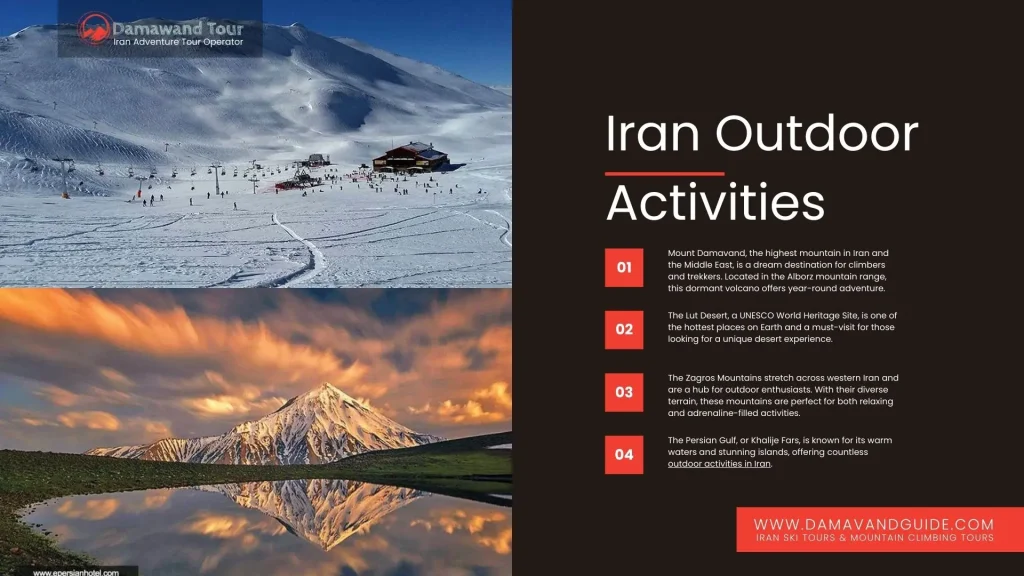
Best Outdoor Activities in Travel to Iran
Iran, a country of diverse landscapes and a four-season climate, is a paradise for nature enthusiasts and adventure seekers. From towering mountains and vast deserts to serene seas and lush jungles, the country offers endless opportunities for exploration. Whether you’re planning to travel to Iran for trekking, skiing, or simply experiencing its breathtaking beauty, here are some of the top outdoor activities in Iran you can enjoy.
Mount Damavand: The Highest Peak in the Middle East
Mount Damavand, the highest mountain in Iran and the Middle East, is a dream destination for climbers and trekkers. Located in the Alborz mountain range, this dormant volcano offers year-round adventure.
- Top Activities:
- Climbing: Suitable for both experienced climbers and beginners with guides.
- Trekking in Iran: The trails leading to the summit provide stunning views of the surrounding valleys.
- Ski Touring: Winter sports enthusiasts can enjoy ski touring on Damavand’s snowy slopes during the colder months.
- Popular Tours: Guided climbing and trekking tours are widely available, ensuring a safe and enjoyable experience.
- Accommodations: Nearby villages, such as Polour and Rineh, offer guesthouses and eco-lodges for comfortable stays.
Visit Our Iran Adventure Tours:
Lut Desert: A Unique Desert Adventure
The Lut Desert, a UNESCO World Heritage Site, is one of the hottest places on Earth and a must-visit for those looking for a unique desert experience.
- Top Activities:
- Desert Safari: Explore the vast sand dunes and mysterious landscapes in off-road vehicles.
- Stargazing: The clear desert skies make it an excellent spot for watching the night sky.
- Photography: Capture surreal scenes of the Kaluts (yardangs) and salt flats.
- Popular Tours: Many tours offer overnight camping in the desert, where you can enjoy the silence and beauty of Iran nature.
- Accommodations: Nomadic-style tents or eco-lodges near Kerman provide authentic stays.
Zagros Mountains: Nature and Adventure
The Zagros Mountains stretch across western Iran and are a hub for outdoor enthusiasts. With their diverse terrain, these mountains are perfect for both relaxing and adrenaline-filled activities.
- Top Activities:
- Jungle Trekking: Explore the lush forests of the Zagros foothills.
- Rafting: Experience thrilling rafting adventures in rivers like Karun and Dez.
- Climbing and Skiing: The snow-capped peaks of the Zagros are ideal for winter sports.
- Popular Tours: Adventure tours often combine trekking, rafting, and cultural experiences with visits to nearby villages.
- Accommodations: Local guesthouses in cities like Shiraz and Yasuj offer easy access to the mountains.
Persian Gulf Region: Sea Adventures
The Persian Gulf, or Khalije Fars, is known for its warm waters and stunning islands, offering countless outdoor activities in Iran.
- Top Activities:
- Water Sports: Enjoy jet skiing, snorkelling, and diving in the clear waters of the Persian Gulf.
- Island Hopping: Explore the Kish, Qeshm, and Hengam Islands, each offering unique experiences.
- Dolphin Watching: Hengam Island is a prime spot for watching playful dolphins in their natural habitat.
- Popular Tours: Many operators provide boat tours and guided activities for exploring the islands.
- Accommodations: From luxury resorts in Kish to cozy eco-lodges in Qeshm, there’s something for every traveler.
Caspian Sea Region: A Tranquil Escape
The Caspian Sea region in northern Iran is known for its lush greenery, serene beaches, and refreshing climate. It’s a perfect destination for relaxation and adventure alike.
- Top Activities:
- Hiking and Trekking: Explore the verdant forests of Mazandaran and Gilan provinces.
- Beach Strolls: Enjoy peaceful walks along the sandy beaches of Ramsar or Bandar-e Anzali.
- Exploring Villages: Visit picturesque villages like Masuleh, famous for its stepped architecture.
- Popular Tours: Nature tours often include visits to tea plantations, waterfalls, and local bazaars.
- Accommodations: Traditional villas, boutique hotels, and eco-lodges cater to visitors seeking tranquility.
Why Iran Is Perfect for Outdoor Adventures
Iran’s diverse geography, from towering Iran mountains to vast Iran deserts, makes it a unique destination for adventurers. Whether you’re interested in trekking, skiing, or relaxing by the sea, the country offers seasonal activities. By exploring these adventure activities in Iran, you’ll experience its unparalleled natural beauty and rich culture firsthand.
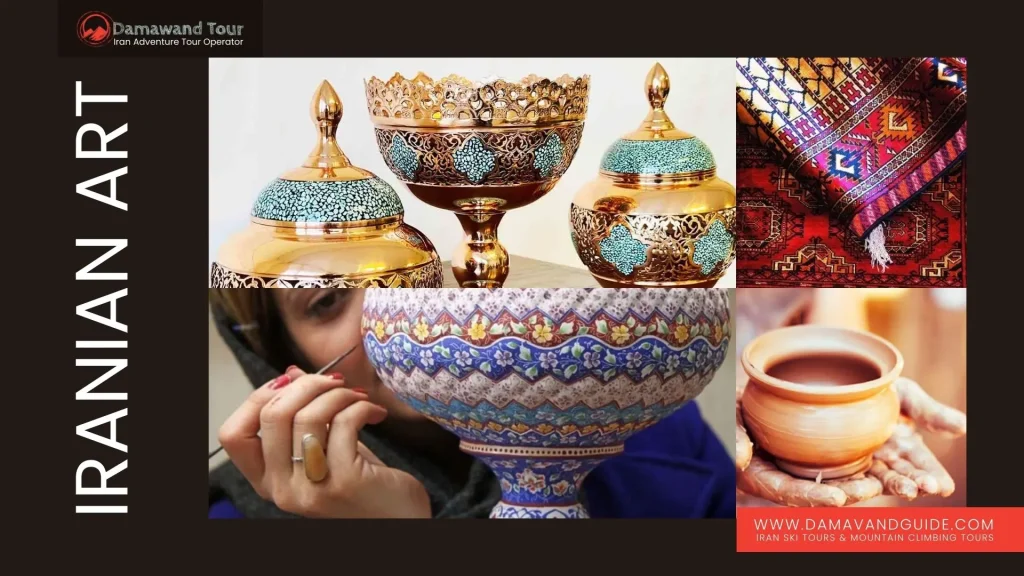
Understanding Iranian Culture: What You Should Know
When you travel to Iran, you enter a world of rich traditions, artistic expression, and literary excellence. Iranian culture is deeply rooted in thousands of years of history, offering visitors a unique chance to experience its art, music, literature, and craftsmanship. Here’s everything you need to know about Iranian culture and how to explore it during your trip.
The Art of Iran: A Blend of Beauty and Craftsmanship
Iranian art is famous for its intricate details and timeless beauty. From delicate miniatures to world-renowned carpets, art in Iran reflects the country’s rich history and creativity.
- Persian Carpets: Known as some of the finest in the world, Persian carpets are a symbol of elegance and skill. Visit bazaars in Isfahan or Tehran to see these masterpieces firsthand.
- Miniature Paintings: These detailed, colorful paintings often depict historical or literary scenes and can be seen in museums and galleries across the country.
- Handicrafts: Iran is home to skilled artisans who create pottery, tilework, and metalwork. Look for authentic souvenirs like turquoise jewelry from Neyshabur or traditional pottery from Yazd.
Iranian Literature: The Land of Poets
Iran is often called the land of poetry, and for good reason. Iranian literature has inspired readers for centuries, with legendary poets like Hafez, Rumi, and Ferdowsi gaining global recognition.
- Hafez and Rumi: These two poets hold a special place in Persian culture. Their poetry, often focused on love, spirituality, and the human experience, is still widely read and celebrated.
- How to Explore: Visit the Tomb of Hafez in Shiraz, a serene site dedicated to the poet. Many visitors enjoy reading his poetry in the peaceful gardens surrounding the tomb.
- Bookstores and Libraries: Tehran’s Book Garden and National Library offer collections of Persian literature that allow visitors to immerse themselves in the country’s literary heritage.
Traditional Iranian Music: A Journey Through Sound
Iranian music is a beautiful blend of traditional instruments and soulful melodies. It reflects the country’s cultural diversity and history.
- Famous Instruments: The santur (hammered dulcimer), tar (a traditional string instrument), and daf (a type of drum) are iconic in Persian music.
- Famous Musicians: Artists like Mohammad Reza Shajarian, a legendary vocalist, have brought Persian music to the global stage.
- How to Experience: Attend live performances or visit Tehran’s Vahdat Hall, a popular venue for traditional and classical Iranian music.
Museums That Celebrate Iranian Culture
For a deeper understanding of Iranian culture, visit its famous museums, where you can see priceless artifacts and learn about the country’s heritage.
- Tehran Museum of Contemporary Art: Home to both Iranian and international works, this museum showcases the evolution of modern and traditional art in Iran.
- National Museum of Iran: Located in Tehran, it houses artifacts from ancient Persia, including pottery, statues, and jewelry from different historical periods.
- Carpet Museum of Iran: This museum in Tehran highlights the beauty and craftsmanship of Persian carpets, displaying rare and antique pieces from across the country.
- Isfahan’s Music Museum: A must-visit for music lovers, this museum offers a collection of traditional Iranian instruments, along with live demonstrations.
Practical Tips for Experiencing Iranian Culture:
- Attend Cultural Events: Plan your visit around Nowruz (Persian New Year) to witness traditional celebrations, or attend a poetry reading event in Shiraz.
- Visit Local Markets: Bazaars are cultural hubs where you can see artisans at work and enjoy local delicacies. The Grand Bazaar of Tehran and Isfahan’s Bazaar are excellent choices.
- Engage with Locals: Iranians are known for their hospitality. Conversations with locals can give you unique insights into the country’s traditions and way of life.
Exploring Iranian art, literature, music, and museums will give you a deeper appreciation for the country’s culture. By immersing yourself in these experiences, you’ll discover the soul of Iran and create lasting memories.
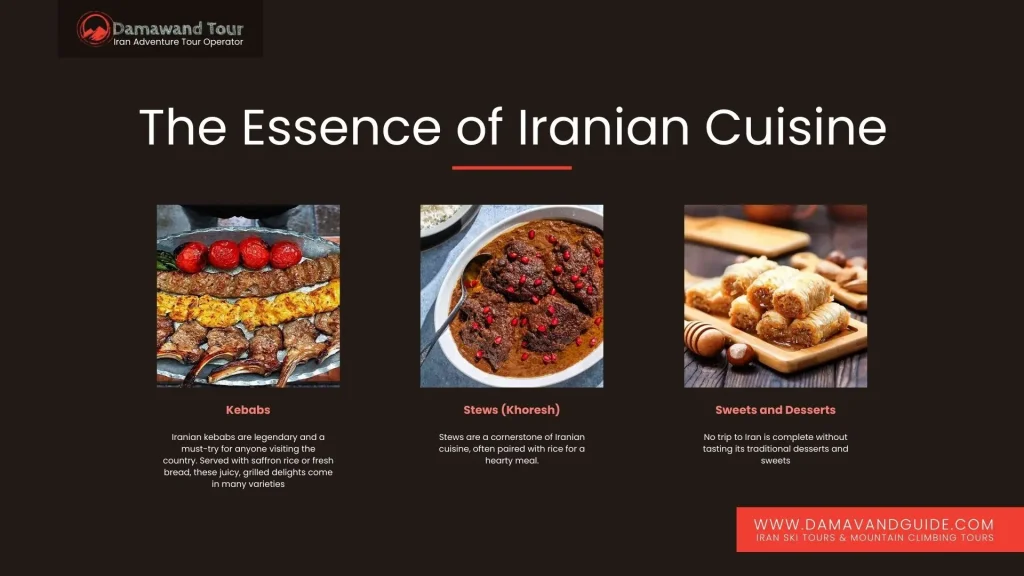
Iranian Cuisine: A Culinary Journey
When you travel to Iran, one of the highlights of your trip will undoubtedly be its rich and diverse culinary offerings. Iranian cuisine is known for its unique flavors, aromatic spices, and vibrant dishes, reflecting the country’s long-standing food traditions. From hearty stews to delicate desserts, a food safari in Iran will take you on an unforgettable journey through its regions and tastes.
The Essence of Iranian Cuisine
Iranian food is a delightful blend of fresh ingredients, fragrant spices, and a balance of flavors. The cuisine is diverse, with dishes that vary by region, but a few staples remain central to Iranian cooking:
- Rice: Often the star of the meal, Iranian rice is long-grained, fluffy, and aromatic. Dishes like “Chelo” (plain steamed rice) and “Tahchin” (baked saffron rice with chicken) are popular across the country.
- Herbs and Spices: Fresh herbs such as parsley, cilantro, and dill are key ingredients, while saffron, turmeric, and dried lime give dishes their distinctive flavors.
Iconic Iranian Dishes
- Kebabs:
Iranian kebabs are legendary and a must-try for anyone visiting the country. Served with saffron rice or fresh bread, these juicy, grilled delights come in many varieties:- Koobideh: Minced lamb or beef, seasoned with onions and spices.
- Joojeh: Marinated chicken kebabs, often cooked with saffron and lemon juice.
- Shishlik: Tender lamb chops, marinated and grilled to perfection.
- Stews (Khoresh):
Stews are a cornerstone of Iranian cuisine, often paired with rice for a hearty meal. Some popular ones include:- Ghormeh Sabzi: A tangy herb stew made with kidney beans, dried lime, and lamb.
- Fesenjan: A rich walnut and pomegranate stew, often served with chicken or duck.
- Gheimeh: A flavorful stew with yellow split peas, dried lime, and lamb, topped with fried potato sticks.
- Sweets and Desserts:
No trip to Iran is complete without tasting its traditional desserts and sweets:-
- Baklava: Layers of flaky pastry filled with nuts and sweetened with rosewater syrup.
- Zoolbia and Bamieh: Deep-fried sweets soaked in syrup, commonly enjoyed with tea.
- Faloodeh: A refreshing dessert made with thin rice noodles, rosewater, and lime juice, perfect for hot days.
-
Regional Food Experiences
Iran’s diverse regions offer unique food experiences that cater to every palate:
- Tehran: The bustling capital is home to vibrant street food culture. Try local favorites like “Sangak” bread, stuffed “Dolmeh,” or a bowl of “Ash Reshteh” (herb and noodle soup) from roadside stalls.
- Shiraz: Known for its fragrant dishes, Shiraz offers specialties like “Kalam Polo” (cabbage and rice) and refreshing “Doogh” (yogurt drink).
- Isfahan: The city is famous for “Beryani,” a rich lamb dish served with bread, and “Gaz,” a delicious nougat-like sweet.
- Northern Iran: The Caspian region features fresh seafood and herb-rich dishes like “Mirza Ghasemi” (smoked eggplant dip) and “Baghali Polo” (dill rice with broad beans and lamb).
- Southern Iran: Coastal areas near the Persian Gulf serve spicy seafood stews, grilled fish, and “Havij Bastani” (carrot juice with ice cream), a unique treat in this region.
Tips for Enjoying Iranian Cuisine:
- Dine with Locals: Iranians are known for their hospitality, and sharing a home-cooked meal is one of the best ways to experience authentic Iranian dishes.
- Visit Traditional Tea Houses: Tea is an integral part of Iranian culture, and tea houses (chai khanehs) are perfect for enjoying a hot cup paired with sweets like Iranian desserts or nuts.
- Explore Local Bazaars: Markets like Tehran’s Grand Bazaar or Isfahan’s Bazaar offer not only spices and ingredients but also ready-to-eat local specialties.
Whether you’re enjoying a street-side kebab in Tehran or savoring a home-cooked stew in a Shiraz courtyard, Iranian cuisine will leave a lasting impression on your palate. A food safari in Iran is not just a culinary journey but a cultural experience that connects you to the heart of the country.
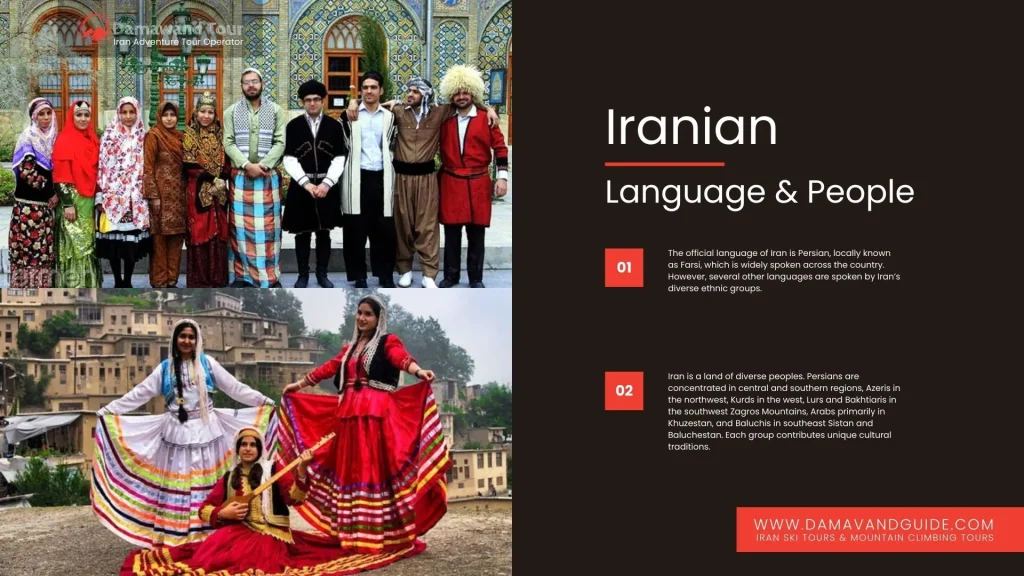
Iranian Language & People
When you travel to Iran, one of the first things you’ll notice is the diversity of its people and languages. Iran is a multi-ethnic country, home to a variety of races and cultures that have coexisted for centuries. This vibrant mix adds to the unique charm of the country, making your Iran holiday an unforgettable cultural experience.
Iranian Languages
The official language of Iran is Persian, locally known as Farsi, which is widely spoken across the country. However, several other languages are spoken by Iran’s diverse ethnic groups.
- Farsi (Persian): The primary language used in government, education, and media. Learning basic phrases in Farsi, such as greetings or polite expressions, can enhance your travel experience.
- Turkish (Azeri): Spoken by the Azerbaijani Turks in northwest Iran, particularly in the province of East Azerbaijan.
- Kurdish: Common in western Iran, particularly in Kurdistan Province.
- Luri and Bakhtiari: These dialects are spoken by the Lur and Bakhtiari people in the southwestern regions.
- Arabic: Spoken in the southern provinces near the Persian Gulf, such as Khuzestan.
- Other Languages: Smaller communities speak Armenian, Assyrian, and Baluchi in specific areas.
Each language reflects the region’s culture and history, offering travelers a deeper connection to the people of Iran.
The People of Iran: A Mosaic of Ethnicities
Iran is home to a rich tapestry of ethnic groups, each contributing to the country’s cultural heritage. Here are some of the major ethnic groups and where they are predominantly located:
- Persians: The largest ethnic group, making up the majority of the population. They primarily inhabit central and southern Iran, including Tehran, Shiraz, and Isfahan.
- Azerbaijani Turks: The second-largest ethnic group, mainly residing in the northwest, particularly in cities like Tabriz and Ardabil.
- Kurds: Found in the western regions, including Kurdistan, Kermanshah, and Ilam provinces, Kurds are known for their vibrant culture and traditional music.
- Lurs: This group resides in the Zagros Mountains in southwestern Iran. The Lur people are renowned for their hospitality and colorful traditional clothing.
- Bakhtiaris: Closely related to the Lurs, Bakhtiaris live in the southwestern provinces and are famous for their nomadic lifestyle and rich history.
- Arabs: Predominantly in the Khuzestan Province along the Persian Gulf, Iranian Arabs have their own distinct customs and traditions.
- Baluchis: This group resides in southeastern Iran, in Sistan and Baluchestan Province, and is known for its unique culture and traditional crafts.
Experiencing the Diversity
Iran’s diversity is not just in language and ethnicity but also in traditions, clothing, and cuisines. Here’s how you can immerse yourself in this cultural mosaic:
- Visit Regional Provinces: Explore the vibrant bazaars of Tabriz in Azerbaijani territory, enjoy the hospitality of Lur communities in the Zagros Mountains, or witness the nomadic lifestyle of Bakhtiaris.
- Learn the Basics of Farsi: Picking up a few phrases can help you learn Farsi and connect with locals during your Iran holiday. If you’re keen on deeper engagement, consider learning Farsi before your trip.
- Attend Cultural Events: Many regions host festivals and celebrations that showcase their unique music, dance, and traditions. For instance, Nowruz (Persian New Year) is celebrated differently across various ethnic groups.
- Explore Local Cuisine: From the aromatic dishes of Persian cuisine to the hearty stews of Kurdish kitchens and the spicy flavors of Baluchi food, each region offers its own culinary delights.
Iranian Hospitality
Regardless of ethnicity or language, Iranian people are renowned for their hospitality and friendliness. Visitors often recount heartwarming stories of locals inviting them for tea or meals, making their trip to Iran truly memorable. This genuine warmth and openness are key to Iran’s appeal as a travel destination.
Exploring the rich diversity of Iranian races and languages adds a unique layer to your journey, allowing you to connect with the country’s vibrant cultural fabric.
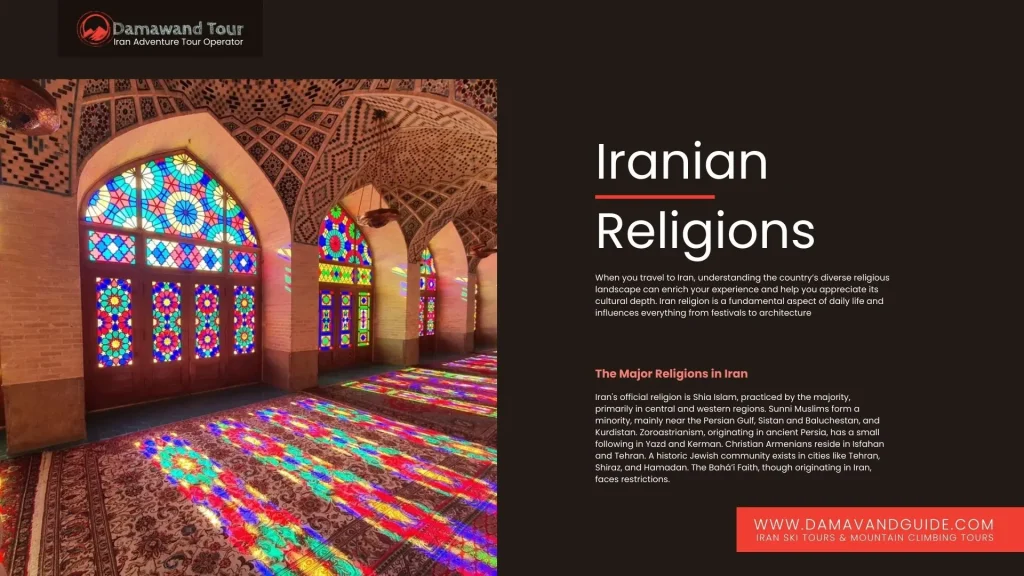
Iranian Religions
When you travel to Iran, understanding the country’s diverse religious landscape can enrich your experience and help you appreciate its cultural depth. Iran religion is a fundamental aspect of daily life and influences everything from festivals to architecture. Here’s an overview of Iran’s religions and how they shape the country’s culture and traditions.
The Major Religions in Iran
Iran is home to a variety of religions, though the majority of the population practices Islam. Here are the main religious groups you’ll find in Iran:
- Islam (Shia and Sunni):
- The official religion of Iran is Shia Islam, followed by the majority of Iranians. Most Shia Muslims live in central and western regions, including cities like Tehran, Qom, and Mashhad.
- Sunni Muslims, a minority group, are predominantly located in areas near the Persian Gulf, Sistan and Baluchestan, and Kurdistan.
- Zoroastrianism:
- One of the world’s oldest religions, Zoroastrianism originated in ancient Persia. Today, its followers are a small community, mainly in Yazd and Kerman. Important Zoroastrian landmarks include the Fire Temple in Yazd and the Tower of Silence.
- Christianity:
- Christian Armenians make up a small but significant part of the population. Many live in Isfahan and Tehran. Churches like Vank Cathedral in Isfahan are popular Iranian religion landmarks.
- Judaism:
- Iran has one of the oldest Jewish communities in the world, with synagogues in cities like Tehran, Shiraz, and Hamadan.
- Bahá’í Faith:
- Though it originated in Iran, the Bahá’í community faces restrictions and practices its faith discreetly.
Religious Ceremonies and Traditions
Religion plays a central role in Iranian culture, and experiencing its ceremonies can provide deep insights into the country.
- Ramadan (Ramazan):
- Ramadan is the holy month of fasting for Muslims, observed throughout Iran. During this time, Muslims fast from dawn to sunset, breaking their fast with a meal called “Iftar.”
- Travel Tips During Ramadan:
- Many restaurants remain closed during the day, but some cater to non-Muslim tourists.
- Avoid eating, drinking, or smoking in public during fasting hours as a sign of respect.
- After sunset, join locals in experiencing delicious Iftar meals at mosques or family-run eateries.
- Ashura:
- A significant event for Shia Muslims, Ashura commemorates the martyrdom of Imam Hussein. Processions, passion plays, and public mourning mark this occasion, especially in cities like Qom and Mashhad.
- Zoroastrian Festivals:
- Celebrate Nowruz, the Persian New Year, alongside Zoroastrians and Muslims alike. This spring festival marks the arrival of the new year and is a vibrant cultural event across Iran.
Visiting Religious and Sacred Sites
Iran is dotted with religious and sacred places that attract both pilgrims and tourists. Respecting local customs is essential when visiting these sites:
- Important Religious Sites:
- Imam Reza Shrine (Mashhad): The holiest site in Iran for Shia Muslims.
- Fāṭima Masumeh Shrine (Qom): A significant pilgrimage site for Shia Muslims.
- Vank Cathedral (Isfahan): A stunning Armenian church with a mix of Islamic and Christian architecture.
- Practical Tips for Visitors:
- Dress modestly: Women should wear a headscarf and loose clothing that covers their arms and legs. Men should avoid wearing shorts.
- Follow local guidelines: Some areas may restrict entry to non-Muslims. Be respectful of these limitations.
- Maintain silence and avoid taking photographs in restricted areas.
Embracing Religious Diversity
Understanding Iranian religions provides a deeper connection to the country’s culture. Whether you’re exploring mosques, churches, or Zoroastrian temples, the diversity of faiths adds a unique layer to your Iran holiday. By respecting these traditions and customs, you can experience the spiritual richness that makes Iran a fascinating destination.
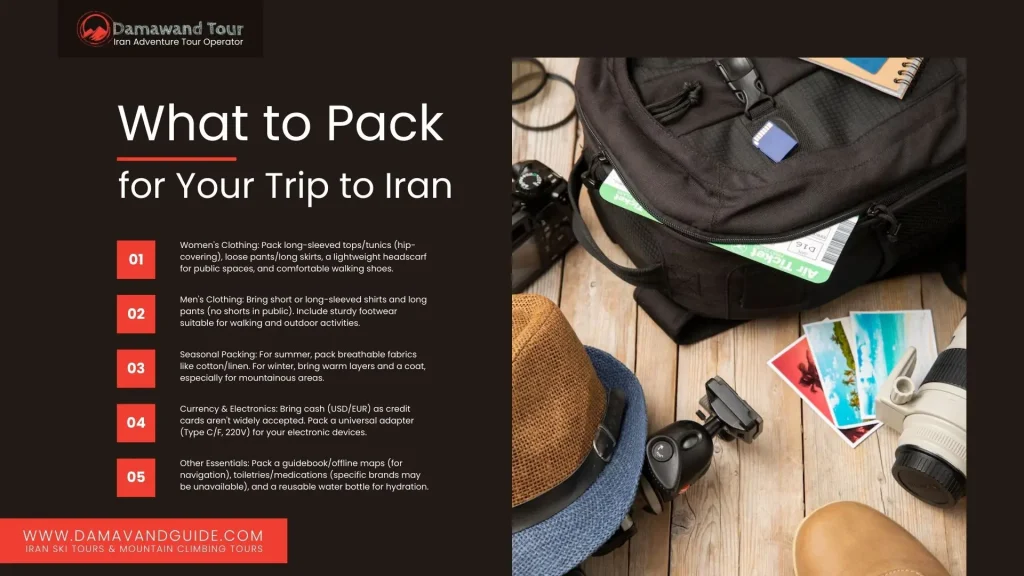
What to Pack for Your Trip to Iran
Packing for a trip to Iran requires thoughtful consideration of the country’s climate, cultural norms, and practical needs. Here’s a detailed Iran travel packing list to help you prepare for your journey.
Clothing Recommendations for Travel to Iran
Iran’s dress code emphasizes modesty, so it’s important to pack appropriately:
- For Women:
- Long-sleeved tops and tunics that cover your hips.
- Loose pants or long skirts.
- A lightweight headscarf to wear in public.
- Comfortable walking shoes for exploring cities and historical sites.
- For Men:
- Short-sleeved or long-sleeved shirts.
- Long pants (shorts are not commonly worn in public).
- Sturdy footwear for outdoor activities.
- Seasonal Considerations:
- In summer, pack breathable fabrics like cotton or linen to stay cool.
- For winter, include warm layers and a coat, especially if you plan to visit mountainous areas.
Essentials to Bring in Your Trip to Iran
Apart from clothing, there are other items that should be on your Iran travel packing list:
- Currency:
- Bring cash, preferably in USD or EUR, as credit cards are not widely accepted in Iran. You can exchange money at official exchange offices or banks.
- Electrical Adapters:
- Iran uses Type C and Type F plugs with 220V voltage. Pack a universal adapter to charge your devices.
- Guidebook or Offline Maps:
- Since internet access may be limited in some areas, it’s helpful to carry an Iran travel guide or download offline maps for navigation.
- Toiletries and Medications:
- Bring basic toiletries, sunscreen, and any prescription medications, as specific brands might not be available locally.
- Reusable Water Bottle:
- Staying hydrated is essential, especially in Iran’s hotter regions. Many places have safe drinking water stations.
Additional Tips:
- Pack a Small Daypack: Ideal for carrying essentials like your phone, wallet, and snacks while sightseeing.
- Bring Snacks for Travel Days: While local food is delicious, having energy bars or dried fruit can be helpful during long road trips.
- Travel Insurance: Ensure you have a comprehensive plan that covers medical emergencies and trip cancellations.
Following these practical tips will ensure you’re well-prepared and comfortable during your travel to Iran. Adhering to cultural norms and packing the right items will help you enjoy your trip while respecting local customs.
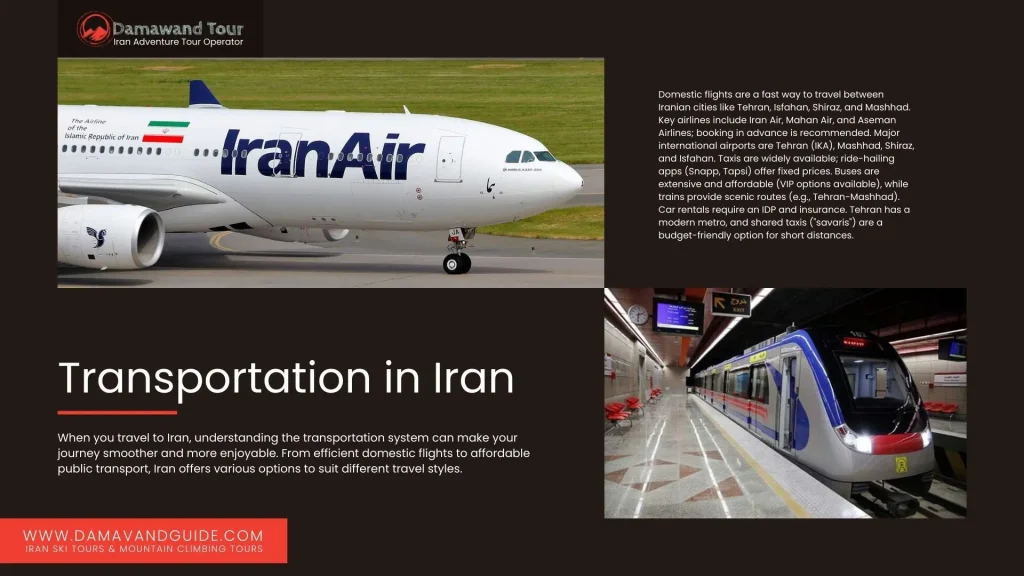
Transportation in Iran: How to Get Around
When you travel to Iran, understanding the transportation system can make your journey smoother and more enjoyable. From efficient domestic flights to affordable public transport, Iran offers various options to suit different travel styles. Here’s a guide to help you navigate transportation in Iran effectively.
Domestic Flights in Iran
With a vast landscape, flying is one of the fastest ways to travel between major cities in Iran. Domestic flights connect popular destinations like Tehran, Isfahan, Shiraz, and Mashhad, making them ideal for long-distance travel.
- Key Airlines:
- Iran Air
- Mahan Air
- Aseman Airlines
- Tips for Domestic Flights:
- Book tickets in advance, especially during holidays or peak seasons.
- Most airports have efficient services, but always arrive early for check-in.
International Airports in Iran
Iran has several international airports that connect the country to the rest of the world.
- Major International Airports:
- Tehran Imam Khomeini International Airport (IKA): The primary gateway for international travelers, located near Tehran.
- Mashhad International Airport: Serves many domestic and international flights, especially for pilgrims visiting the Imam Reza Shrine.
- Shiraz International Airport: A convenient option for travelers heading to southern Iran.
- Isfahan International Airport: Ideal for those exploring central Iran and its historical sites.
Taxis and Ride-Hailing Apps
Taxis are widely available in all cities, offering a convenient way to get around.
- Traditional Taxis: Easily found near hotels, airports, and major landmarks. Negotiate the fare before starting the ride if a meter is not available.
- Ride-Hailing Apps: Snapp and Tapsi are popular ride-hailing apps in Iran. These apps offer fixed prices and a more comfortable experience for tourists.
Buses and Trains in Iran
- Buses: Iran’s bus network is extensive and affordable. Choose between luxury buses for long distances and local buses for city travel.
- Tip: Book tickets for VIP buses for added comfort on longer routes.
- Trains: Trains are a scenic way to explore Iran, especially for routes like Tehran to Mashhad. First-class tickets provide added comfort.
Renting a Car in Iran
Renting a car is a good option for those wanting more flexibility.
- Requirements: You’ll need an international driving permit (IDP) and a valid passport.
- Tips for Renting:
- Ensure the rental includes insurance.
- Be cautious while driving, as traffic rules may differ from what you’re used to.
Navigating Public Transport
- Metro Systems: Tehran’s metro is modern, clean, and affordable, making it a great choice for navigating the capital.
- Shared Taxis: Known as “savaris,” these are a cost-effective way to travel short distances but may involve sharing the ride with others.
Using this Iran travel guide to understand transportation options will help you plan your itinerary efficiently. Whether you’re flying across the country, taking a scenic train ride, or exploring cities by metro, getting around Iran is both convenient and budget-friendly.
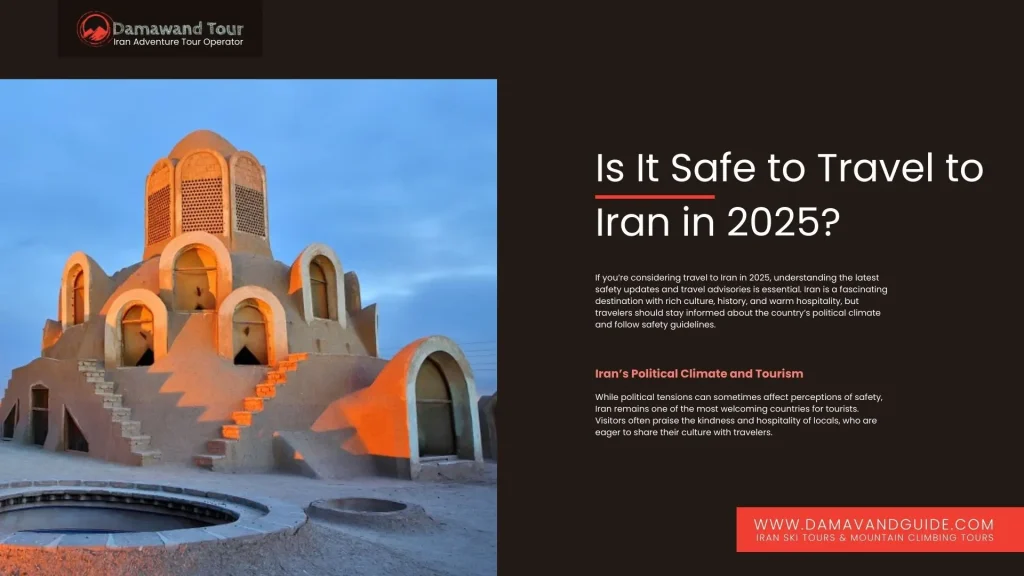
Iran Travel Advisory: Is It Safe to Travel to Iran in 2025?
If you’re considering travel to Iran in 2025, understanding the latest safety updates and travel advisories is essential. Iran is a fascinating destination with rich culture, history, and warm hospitality, but travelers should stay informed about the country’s political climate and follow safety guidelines. Here’s a detailed look at Iran travel advisory updates and tips for a safe and enjoyable trip.
Current Iran Travel Advisories
Travel advisories for Iran vary depending on the country of origin. Here’s an overview of recommendations from major nations:
- UK Travelers: The UK government advises caution for travel to Iran, recommending that visitors avoid areas near the borders of Iraq, Afghanistan, and Pakistan due to potential instability. However, major tourist destinations like Tehran, Isfahan, and Shiraz remain safe for travel.
- USA Travelers: The US State Department suggests exercising increased caution due to political sensitivities. Tourists are encouraged to travel with a guide or group for added safety.
- Australian Travelers: Australian travel advisories highlight the need for cultural awareness and caution in rural or remote areas but endorse travel to urban and historical regions with proper preparation.
- Russian Travelers: Iran is considered generally safe for Russian tourists. Direct flights from Moscow to Tehran, along with strong diplomatic ties, make travel convenient.
- Chinese Travelers: With growing tourism connections, Iran is welcoming an increasing number of Chinese visitors. Major cities are safe, and many hotels and tour agencies cater to Chinese-speaking tourists.
Safety Tips for Traveling in Iran
While Iran is widely regarded as a safe destination for tourists, it’s important to take precautions, especially if you’re a solo traveler or visiting less-populated areas.
- For Female Travelers:
- Dress modestly to respect cultural norms. Women should wear a headscarf and loose-fitting clothing.
- Avoid traveling alone at night, especially in rural or unfamiliar areas.
- Use ride-hailing apps like Snapp for safe and reliable transportation.
- For Solo Travelers:
- Stick to well-traveled routes and tourist hotspots like Persepolis, Yazd, and the Caspian Sea region.
- Inform someone about your itinerary, especially if you plan to visit remote areas.
- Carry a local SIM card to stay connected and use navigation apps.
- For Remote Areas:
- Avoid border regions near Iraq, Afghanistan, and Pakistan, which are flagged as high-risk zones in many Iran travel advisories.
- Hire a guide or join a tour group when visiting deserts or mountains to ensure safety.
Iran’s Political Climate and Tourism
While political tensions can sometimes affect perceptions of safety, Iran remains one of the most welcoming countries for tourists. Visitors often praise the kindness and hospitality of locals, who are eager to share their culture with travelers.
Tourist-friendly cities such as Tehran, Isfahan, and Shiraz are equipped with infrastructure to accommodate international visitors. Popular attractions like the Imam Reza Shrine, Naqsh-e Jahan Square, and the Lut Desert are regularly visited by tourists from around the globe.
Practical Iran Travel Safety Considerations:
- Travel Documents: Keep a copy of your passport and visa with you at all times, and store the originals in a safe place.
- Emergency Numbers: Familiarize yourself with local emergency numbers and your country’s embassy contact details.
- Currency and Payments: Carry cash in Iranian Rials, as international credit cards are not widely accepted. Exchange money only at official exchange offices.
By staying informed about the Iran travel advisory for your country and following these safety tips, you can confidently plan your trip to this captivating destination. Whether you’re exploring ancient ruins, vibrant bazaars, or stunning landscapes, Iran offers a unique and rewarding travel experience for those prepared to respect its culture and guidelines.
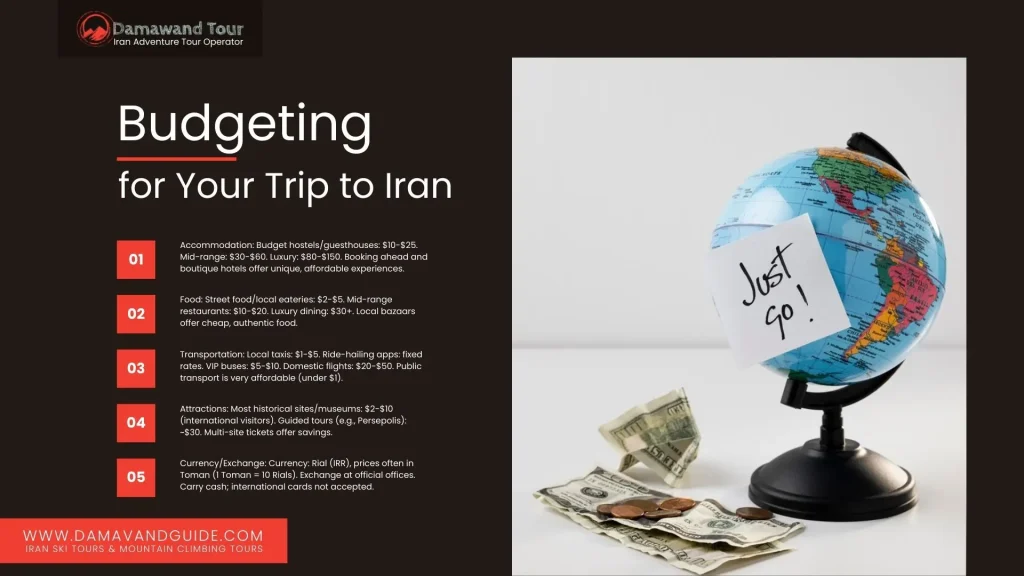
Budgeting for Your Trip to Iran: Cost Breakdown in 2025
Planning your travel to Iran can be an affordable and enriching experience. With its reasonable costs for accommodation, food, and attractions, Iran is a great destination for budget-conscious travelers. Here’s a detailed breakdown of Iran travel costs to help you budget effectively for your trip.
Accommodation Costs in Iran
Accommodation in Iran caters to various budgets, from luxurious hotels to affordable guesthouses.
- Budget Options: Hostels and guesthouses range from $10 to $25 per night.
- Mid-Range Hotels: Expect to pay between $30 and $60 per night for a comfortable stay.
- Luxury Hotels: High-end accommodations in cities like Tehran, Isfahan, or Shiraz can cost $80 to $150 per night.
Budget Tip: Booking in advance and exploring traditional Iranian boutique hotels can save money while offering a unique experience.
Food Costs in Iran
Iranian cuisine is not only delicious but also budget-friendly.
- Street Food and Local Eateries: Meals can cost as little as $2 to $5 for popular dishes like kebabs, falafel, or Ash Reshteh (noodle soup).
- Mid-Range Restaurants: A three-course meal in a decent restaurant typically costs around $10 to $20 per person.
- Luxury Dining: Upscale restaurants may charge $30 or more per person for an elaborate dining experience.
Budget Tip: Explore local bazaars for fresh produce and snacks, which are both affordable and authentic.
Transportation Costs in Iran
Transportation in Iran is efficient and inexpensive.
- Taxis and Ride-Hailing Apps: Local taxis charge around $1 to $5 for short rides, while ride-hailing apps like Snapp offer fixed and economical rates.
- Buses: A long-distance bus ride on a VIP bus costs approximately $5 to $10, depending on the distance.
- Domestic Flights in Iran: Tickets for domestic flights range from $20 to $50, making air travel a convenient option for long distances.
Budget Tip: Use public transport, such as buses or the Tehran metro, which cost less than $1 per ride.
Attraction Costs in Travel to Iran
Visiting Iran’s attractions is highly affordable.
- Entrance Fees: Most historical sites and museums charge between $2 and $10 for international visitors.
- Guided Tours: Prices for guided tours to places like Persepolis or the Lut Desert start at around $30 per person.
Budget Tip: Purchase a multi-site ticket when available to save on entrance fees.
Currency and Exchange in Your Iran Holiday
Iran’s official currency is the Iranian Rial (IRR), but prices are often quoted in Toman (1 Toman = 10 Rials).
- Exchange Rates: Exchange your currency at official exchange offices for the best rates.
- Payment Options: International credit cards are not accepted, so carry enough cash for your trip.
Additional Budget Tips for Travel to Iran:
- Travel during the off-season (summer or winter) for discounts on accommodations and tours.
- Stay in smaller cities or towns, where costs are lower than in major cities like Tehran.
- Bargain in bazaars and with taxi drivers for better prices, but be polite and reasonable.
By keeping these Iran travel costs and tips in mind, you can plan a memorable trip without breaking the bank. Iran offers incredible experiences at an affordable price, making it a perfect destination.
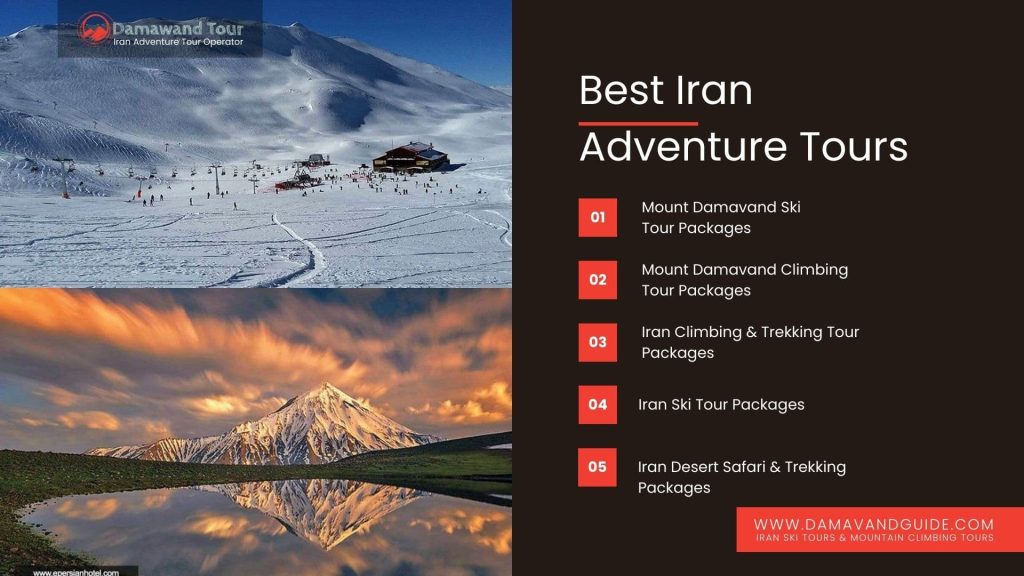
FAQ for Travel to Iran
Here are 10 frequently asked questions about traveling to Iran, with practical answers to help you plan your trip.
1. What is the best time to visit Iran?
The best time to travel to Iran is during spring (March to May) and autumn (September to November). During these seasons, the weather is mild and pleasant, making it ideal for sightseeing and outdoor activities.
2. Do I need a visa to travel to Iran?
Yes, most travelers need a visa to enter Iran. You can apply for an e-visa or get a visa on arrival (VOA) at major airports if your nationality is eligible. Always check the latest Iran travel information before applying.
3. Is Iran safe for tourists in 2025?
Yes, Iran is generally safe for tourists. Popular destinations like Tehran, Isfahan, Shiraz, and Yazd are tourist-friendly and secure. However, it’s recommended to avoid areas near the borders of Iraq, Afghanistan, and Pakistan. Always stay updated with Iran travel advisories for the latest safety recommendations.
4. What should I wear when traveling to Iran?
Iran has a modest dress code:
- For Women: Wear a headscarf, loose clothing that covers your arms, and long pants or skirts.
- For Men: Avoid shorts and sleeveless shirts in public.
While the dress code is mandatory, it’s more relaxed in urban areas and tourist hubs.
5. Can I use credit cards in Iran?
International credit and debit cards are not widely accepted in Iran due to banking restrictions. You’ll need to carry cash in Iranian currency, which you can exchange at official exchange offices. Alternatively, you can use local prepaid travel cards.
6. What language is spoken in Iran?
The official language of Iran is Persian (Farsi). English is spoken in major cities, especially by younger people and in tourist areas. Learning a few basic Farsi phrases can enhance your Iran tours experience.
7. Is Iran expensive to visit?
Iran is an affordable destination compared to many countries.
- Budget accommodations start at $10–$25 per night.
- Meals at local restaurants cost $2–$5.
- Entry to historical sites and attractions is typically $2–$10.
With proper planning, your Iran travel packages can be budget-friendly.
8. Can I drink alcohol in Iran?
No, alcohol is prohibited in Iran for both locals and tourists. However, you can enjoy a wide variety of non-alcoholic beverages like herbal teas, juices, and Doogh (a yogurt-based drink).
9. How can I stay connected to the internet in Iran?
You can purchase a local SIM card from providers like Irancell or Hamrah-e-Aval for internet access. Wi-Fi is also available in most hotels, cafes, and public areas. Downloading a VPN before your trip is recommended, as some websites and apps may be restricted.
10. What are the must-see attractions in Iran?
Iran is filled with incredible landmarks and attractions. Some must-see spots include:
- Persepolis: The ancient ceremonial capital of the Achaemenid Empire.
- Naqsh-e Jahan Square (Isfahan): A UNESCO World Heritage Site with stunning Islamic architecture.
- Imam Reza Shrine (Mashhad): One of the holiest sites in Iran.
- Lut Desert: A breathtaking UNESCO-listed desert for adventurous travelers.
- Golestan Palace (Tehran): A historic gem in the bustling capital.
Conclusion
Iran is a destination like no other, offering a mix of history, culture, and natural wonders that will leave you in awe. From navigating bustling cities like Tehran to experiencing the tranquility of the Caspian Sea, the opportunities for discovery are endless. However, successful travel to this captivating country requires thoughtful preparation, including understanding cultural norms, budgeting wisely, and choosing the best attractions to visit.
With the insights shared in this Iran travel ultimate guide, you’re now equipped to explore this fascinating destination with confidence. By planning ahead and respecting Iran’s rich traditions, you’ll not only have a smooth and enjoyable trip but also create unforgettable memories. So, pack your bags, embrace the adventure, and get ready to uncover the magic of Iran!

